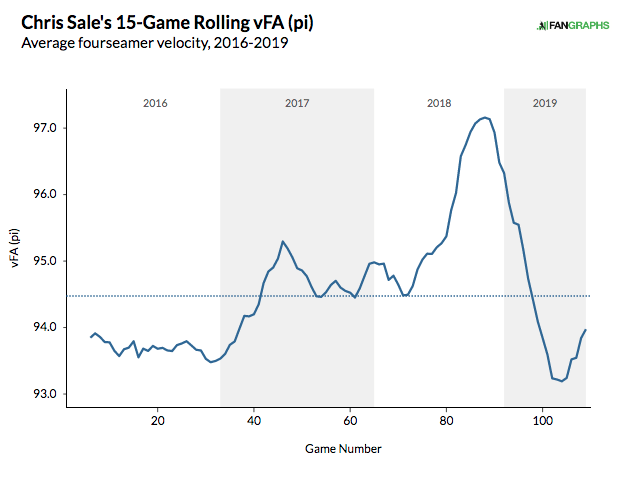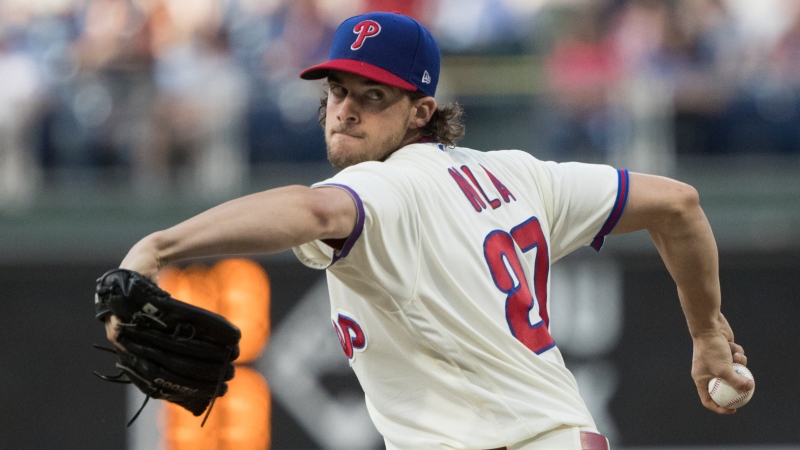Zerillo’s MLB Daily Betting Model, 7/13: Can Aaron Nola Continue His Good Form vs. Corbin, Nationals?
Bill Streicher-USA TODAY Sports. Pictured: Aaron Nola
- Sean Zerillo's MLB model helps you find edges when betting moneylines and over/unders for the full game and first five (F5) innings.
- He analyzes Saturday's slate of games, including how to bet Phillies-Nationals (7:15 p.m. ET) and Braves-Padres (8:40 pm. ET).
- Plug in your odds to the spreadsheet at the bottom of this article to see where you might have an edge.
While I did select a bunch of plays for Saturday, I left many more on the cutting room floor. While there were some teams (Padres, Phillies) that I immediately felt good about taking based upon line value, there were others that I had trepidation about playing.
It's always important to completely think through why you shouldn't make a pick as opposed to only focusing on why you should, so with that I mind I wanted to examine a bunch of interesting pitching situations today — including the Red Sox-Dodgers matchup and Twins-Indians matchup.
Recapping Yesterday's MLB Model
At writing yesterday, the model would have gone 2-3 against full-game moneylines, and 2-2-3 against moneylines for the first five innings (F5).
My plays went 3-3, and I finished down 0.15 units for the day.
It was a mixed day in terms of generating Closing Line Value (CLV).
I gained 21 cents against the Cleveland moneyline (-127 to -148), but lost 18 cents against the Reds moneyline (+109 to +127), and was up 7 cents overall on sides. The under in Boston also dropped from 11.0 to 10.5.
MLB Betting Model for Saturday, July 13
All odds as of Saturday morning (view live MLB odds). Stay tuned on Twitter or follow me in The Action Network App for my entire betting card for Saturday.
Today, the model recommends nine full-game moneylines and five moneylines for the first five-innings (F5).
As of writing, the 3.5% trigger threshold officially marked the Blue Jays, Dodgers, Mariners, Marlins, Padres, Pirates, Phillies, Reds, and Twins as full-game plays. The model also likes the Blue Jays, Marlins, Pirates, and Reds, in addition to the Rangers as F5 plays.
I'm still not particularly interested in playing underdogs during the first few days following the All-Star break — so I crossed off many of these teams.
I'm still considering each of the Dodgers, Reds, and Twins — but all are taking a ton of public money and have each seen their lines tick upwards from their opening number; and all three games have starting pitchers worth monitoring.
Chris Sale will face the Dodgers, Kyle Freeland will return from Triple-A to face the Reds, and the Indians and Twins will send out a couple of regression candidates in Trevor Bauer and Jake Odorizzi.
Chris Sale's 3.32 FIP and 3.12 xFIP shows that his 4.04 ERA has room to improve, and his average velocity has hovered around 94-95 mph over his past five starts, as opposed 91-93 mph in his early 2019 outings.

For the season, Sale's average fastball velocity is 93.7 mph, down 2 mph from 2018. He had a 3.46 FIP and a 3.58 xFIP in 2016, his final season with the White Sox – when his fastball averaged 93.6 mph.
But the recent trend is certainly a positive sign, and I'll continue to monitor how he looks from start to start.
Kyle Freeland pitched himself into Cy Young contention down the stretch in 2018 but lost his command in 2019 while allowing 16 home runs in 59.1 innings over 12 starts.
It seems odd that the Rockies would recall him now after posting an 8.80 ERA over six starts at Triple-A, but the lefty was sharp in his most recent outing (7 IP, 4 H, 1 R, 2 BB, 9 K) and perhaps the Rockies' finally saw what they were looking for.
Freeland throws his three fastballs (four-seamer, cutter, two-seamer) a combined 85% of the time, and the cutter generates a lot of weak contact and whiffs:
Kyle Freeland, 92mph Fastball (foul) and 90mph Back Foot Cutter (swinging K), Overlay. pic.twitter.com/1RmaETabMo
— Rob Friedman (@PitchingNinja) March 29, 2019
If I only gave you the following two stat profiles, which pitcher would you prefer?
- Pitcher A: 3.58 FIP, 4.60 xFIP, 4.24 SIERA, .306 xwOBA, 18.4% K-BB, 87.3 mph exit velocity
- Pitcher B: 4.09 FIP, 4.40 xFIP, 4.20 SIERA, .317 xwOBA, 17.6% K-BB, 88.4 mph exit velocity
Pitcher A is the clear lean, allowing weaker contact with a stronger command of the strike zone.
You probably already guessed that the two pitchers are Jake Odorizzi and Trevor Bauer and that Bauer is pitcher B.
Either way, this head-to-head comparison is likely closer than you anticipated that it would be.
Bauer has a career 3.85 FIP and 3.98 xFIP, and his 2018 season (2.44, 3.14) is beginning to look like an outlier as opposed to growth.
Odorizzi has struggled of late, allowing 17 runs in his last four starts and 18.1 innings pitched, and while I do think that there is line value on the first-place Twins tonight, Cy Young caliber Bauer can emerge on any given day:
Trevor "Complete Game Shutout" Bauer is his name.
Show some respect. pic.twitter.com/8pz1p4zmPi
— Cleveland Indians (@Indians) June 17, 2019
So, three underdogs, that I see value on that I have compelling reasons not to pick — though I am still slightly tempted by the Dodgers.
As for model plays that I have already locked in, I like both the Padres and the Phillies on Saturday.
I think Julio Teheran as a strong fade target at the moment. He has 47 strikeouts against 33 walks since the beginning of May, and his two strongest outings both came against the Marlins.
Teheran's rolling xwOBA is also skyrocketing:

Joey Lucchesi is very steady, allowing more than four runs in just six of his 43 major league outings, and the Padres have an above average offense when Fernando Tatis Jr. is hitting at the top of their lineup.
Aaron Nola struggled early in 2019, including two bad starts against the Nationals but he has found his level of late and I think people will be basing their betting off of those head-to-head losses.
Nola's rolling xwOBA has been relatively streaky throughout his career, an argument against permanent ace status, but I'm happy to hop on board in the midst of a potential heater:

Speaking of heaters, I'm going to continue riding the Wade Miley wave. The lefty is now 24-10 (70.6% +$973, 28.6% ROI) on the full-game moneyline over the past two seasons, with his team winning by an average of over two runs, and I think he continues to fly under the radar.
I'll also be taking advantage of optimal doubleheader strategy by targeting the Rays in the second game of their doubleheader against the Orioles.
With the current direction of these teams, I parlayed the Rays in both ends of the two-game set, but if they win game 1 I might also take them on the runline in Game 2 — and that would be the bet that I would recommend that you make if you play the situation straight up.
Bets (So Far) for July 13
- Houston Astros (-123) Game Moneyline
- Philadelphia Phillies (-111) Game Moneyline
- San Diego Padres (-115) Game Moneyline
- Parlay (+125): Rays (-200) Game One with Rays (-200) Game Two
- Over 9 (-116), Pirates at Cubs
- Under 10 (-115), White Sox at Athletics
- Over 8.5, (-115), Minnesota at Cleveland
- Under 14 (-115), Reds at Rockies
Stay tuned on Twitter or follow me in The Action Network App for my entire betting card for Saturday, July 13.
Zerillo's Full MLB Model, 7/13
Download the Excel doc with my projections to input odds from your sportsbook. These projections cover the full game and First 5 moneylines and over/unders. A sample of one of the sheets is below.
How would you rate this article?





